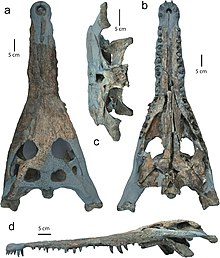澎湖鳄属
| 澎湖鳄属 化石时期:
| |
|---|---|

| |
| 科学分类 | |
| 界: | 动物界 Animalia |
| 门: | 脊索动物门 Chordata |
| 纲: | 爬行纲 Reptilia |
| 目: | 鳄目 Crocodilia |
| 科: | 长吻鳄科 Gavialidae |
| 属: | †澎湖鳄属 Penghusuchus Shan et al., 2009 |
| 模式种 | |
| 潘氏澎湖鳄 Penghusuchus pani Shan et al., 2009
| |
澎湖鳄属(学名:Penghusuchus),为一种生活于中新世中后期的已灭绝长吻鳄类,化石标本发现于台湾澎湖的西屿乡内垵村海岸的中新统渔翁岛层,标本包含近全身的骨架,于2009年由单希瑛等人描述,模式种为潘氏澎湖鳄(学名:Penghusuchus pani)。其为一种体型中等的长吻鳄类,估计总长约为4.5-5公尺[1][2]。
研究历史
[编辑]2006年3月25日,怪手驾驶潘明国先生在澎湖西屿内垵游憩区海岸,干潮低潮线附近玄武岩间的砂岩夹层中发现鳄鱼牙齿化石暴露,并将整具化石挖出,而后标本被转送至台中国立自然科学博物馆修复、研究与收藏[3]。潘氏澎湖鳄的整体保存率将近70%[3],出土地层为中部中新统渔翁岛层(早于一千万年前),根据地层中的古孢粉证据推测,其所属沉积岩年代约为距今1700-1500万年前的中新世中期,是台湾目前已知最古老且最完整的脊椎动物化石之一。其属名源自发现地澎湖,种名为纪念与彰显发现者潘明国先生[1]。目前它被认为和更新世日本与台湾的丰玉姬鳄、全新世中国的韩愈鳄代表东亚独特且已灭绝的鳄类支系[4][5][6][7][8]。
形态描述
[编辑]澎湖鳄有以下辨识特征,像是:前额骨、泪骨和轭骨前凸等长;额骨前凸前缘些微截断并和鼻骨以W字形相接;内鼻孔(choana)呈三角形,前缘尖锐,往前延伸为鼻咽管(nasopharyngeal duct)处之边缘在翼骨腹侧形成Y字形的明显凸脊(ridge);在眼下孔(suborbtial fenestrae)范围之边缘有五颗上颌部牙齿的存在;上颔骨前段最大齿槽为第七个且明显澎大;隅骨有一个背中凸起,将上隅骨排除在外下颔孔的后背测边缘外[1]。其中,上颔部最大齿为第七齿之特征在所有鳄类中仅见分布于更新世日本和台湾的丰玉姬鳄以及全新世中国的韩愈鳄,显示这三个东亚鳄类具有共同的独特特征,不过,澎湖鳄的估计体型(约4.5-5公尺)比韩愈鳄和丰玉姬鳄(超过6公尺)来的较小,且上述之部分特征也和后两者不同[4][5][6][7][8]。
尽管长期以来被认为属于马来鳄亚科,2019年的一篇研究指出丰玉姬鳄和澎湖鳄具有长吻鳄类的形态特征,当中澎湖鳄包含了以下特征:在椎弓(neural arch)上有椎勾突(axial diapophysis);椎体腹面有成对的、分叉的椎体下突(hypapophysis);髂骨片(iliac blade)上有明显的前突起且背侧非常平滑;肱骨的三角肌脊(deltopectoral crest)较为不明显;位于身体中线背侧或骨盆区域的骨板宽大于长,呈长方形并带有一个前突;基枕骨结节(basioccipital tubera)非常粗壮,外枕骨(exoccipital)粗壮的突起参与整个结节的组成;枕面的头颅-方骨通道(cranio-quadrate passage)被外枕骨的腹面凸起遮蔽;下颚的夹骨联合(splenial symphysis)延伸约5-7个齿槽的长度,并形成一个宽大或狭窄的V形。这些特征通常都只见于长吻鳄类,显示这两个东亚鳄类同时具备马来鳄类和长吻鳄类的特征,填补这两个长喙鳄类(longirostrine crocodylians)之间演化的空缺。[7]
透过脊椎长度进行的体长估算显示,潘氏澎湖鳄体长约为4.49公尺。由于其尾椎前的脊椎缝线皆已愈合,可以判断正模标本为成熟个体。[2]
亲缘关系
[编辑]饭岛等人于2018年基于形态学特征重建的系统发生树,显示澎湖鳄属是马来鳄亚科的成员[5]:
| 鳄科Crocodylidae |
| |||||||||||||||||||||||||||||||||||||||||||||||||||||||||||||||||||||||||||
基于对已灭绝类群的形态学研究,人们长期以来认为马来鳄亚科(包括现生马来长吻鳄)属于鳄科(Crocodylidae),与长吻鳄类(gavialoids)没有密切关系[9]。然而,后来利用DNA序列进行的分子研究一致表明,马来鳄属(以及过去被归在马来鳄亚科中的其他相关灭绝物种)实际上属于长吻鳄超科(Gavialoidea)[10][11][12][13][14][15][16],甚至新的形态证据也支持此一论点[7][17]。
Lee & Yates在2018年同时使用形态学、分子生物学(DNA定序)和地层学(化石年龄)资料进行支端定年法(Tip-dating)所重建的系统发生树,显示澎湖鳄属是一种长吻鳄类,与恒河鳄和马来长吻鳄皆有亲缘关系[15]:
| 长吻鳄科Gavialidae |
| ||||||||||||||||||||||||||||||||||||||||||||||||||||||||||||||||||||||||
Rio和Mannion在2021年使用全新、迄今最全面的鳄类形态数据库(包含144物种单元和330个特征),仅使用形态证据进行分析便成功重建涵盖传统马来鳄亚科和长吻鳄科的长吻鳄超科(Gavialoidea)。澎湖鳄属在分析结果中也被归类为长吻鳄超科,但并未如过去常见分析结果和丰玉姬鳄属形成姐妹单元。[17]
饭岛等人在2022年发表中国南部全新世的韩愈鳄属(Hanyusuchus),其重建的亲缘关系树显示韩愈鳄属和澎湖鳄属、丰玉姬鳄属有著最密切的亲缘关系:[8]
| |||||||||||||||||||||||||||||||||||||||||||||||||||||||||||||||||||||||||||||||||||||||||||||||||||||||||||||||||||||||||||||||||||||||||||||||||||||||||||||||||||||||||||||||||||||||||||||||||||||||||||||||||||||||||||||||
参考文献
[编辑]- ^ 1.0 1.1 1.2 Shan, Hsi-yin; Wu, Xiao-chun; Cheng, Yen-nien; Sato, Tamaki. Sues, Hans-Dieter , 编. A new tomistomine (Crocodylia) from the Miocene of Taiwan. Canadian Journal of Earth Sciences. 2009-07, 46 (7). ISSN 0008-4077. doi:10.1139/E09-036 (英语).
- ^ 2.0 2.1 Iijima, Masaya; Kubo, Tai. Vertebrae-Based Body Length Estimation in Crocodylians and Its Implication for Sexual Maturity and the Maximum Sizes. Integrative Organismal Biology. 2020-01-01, 2 (1) [2023-05-15]. ISSN 2517-4843. PMC 7891683
 . PMID 33791579. doi:10.1093/iob/obaa042. (原始内容存档于2022-06-23) (英语).
. PMID 33791579. doi:10.1093/iob/obaa042. (原始内容存档于2022-06-23) (英语).
- ^ 3.0 3.1 许志鹏. 台灣最古老、最完整的脊椎動物化石 – 潘氏澎湖鱷簡介. 科学online 高瞻自然科学教学资源平台. 国立台湾大学. 2011-07-19 [2023-05-15]. (原始内容存档于2023-05-16).
- ^ 4.0 4.1 Kobayashi, Yoshitsugu; Tomida, Yukimitsu; Kamei, Tadao; Eguchi, Taro. Kobayashi, Y., Tomida, Y., Kamei, T., & Eguchi, T. (2006). Anatomy of a Japanese tomistomine crocodylian, Toyotamaphimeia machikanensis (Kamei et Matsumoto, 1965), from the middle Pleistocene of Osaka Prefecture: the reassessment of its phylogenetic status within Crocodylia. National Science Museum Monographs, 35, i-121.. National Science Museum Monographs. 2006, 35: i-121 [2023-05-15]. (原始内容存档于2023-05-18).
- ^ 5.0 5.1 5.2 Iijima, Masaya; Momohara, Arata; Kobayashi, Yoshitsugu; Hayashi, Shoji; Ikeda, Tadahiro; Taruno, Hiroyuki; Watanabe, Katsunori; Tanimoto, Masahiro; Furui, Sora. Toyotamaphimeia cf. machikanensis (Crocodylia, Tomistominae) from the Middle Pleistocene of Osaka, Japan, and crocodylian survivorship through the Pliocene-Pleistocene climatic oscillations. Palaeogeography, Palaeoclimatology, Palaeoecology. 2018-05, 496 [2023-05-15]. doi:10.1016/j.palaeo.2018.02.002. (原始内容存档于2019-08-17) (英语).
- ^ 6.0 6.1 Ito, Ai; Aoki, Riosuke; Hirayama, Ren; Yoshida, Masataka; Kon, Hiroo; Endo, Hideki. The Rediscovery and Taxonomical Reexamination of the Longirostrine Crocodylian from the Pleistocene of Taiwan. Paleontological Research. 2018-04, 22 (2). ISSN 1342-8144. doi:10.2517/2017PR016 (英语).
- ^ 7.0 7.1 7.2 7.3 Iijima, Masaya; Kobayashi, Yoshitsugu. Mosaic nature in the skeleton of East Asian crocodylians fills the morphological gap between “Tomistominae” and Gavialinae. Cladistics. 2019-12, 35 (6) [2023-05-15]. ISSN 0748-3007. doi:10.1111/cla.12372. (原始内容存档于2020-06-10) (英语).
- ^ 8.0 8.1 8.2 Iijima, Masaya; Qiao, Yu; Lin, Wenbin; Peng, Youjie; Yoneda, Minoru; Liu, Jun. An intermediate crocodylian linking two extant gharials from the Bronze Age of China and its human-induced extinction. Proceedings of the Royal Society B: Biological Sciences. 2022-03-09, 289 (1970) [2023-05-15]. ISSN 0962-8452. PMC 8905159
 . PMID 35259993. doi:10.1098/rspb.2022.0085. (原始内容存档于2022-03-09) (英语).
. PMID 35259993. doi:10.1098/rspb.2022.0085. (原始内容存档于2022-03-09) (英语).
- ^ Brochu, Christopher A.; Gingerich, Philip D. New tomistomine crocodylian from the middle Eocene (Bartonian) of Wadi Hitan, Fayum Province, Egypt.. THE UNIVERSITY OF MICHIGAN. 2000.
- ^ Harshman, John; Huddleston, Christopher J.; Bollback, Jonathan P.; Parsons, Thomas J.; Braun, Michael J. Baker, Allan , 编. True and False Gharials: A Nuclear Gene Phylogeny of Crocodylia. Systematic Biology. 2003-06-01, 52 (3) [2023-05-15]. ISSN 1076-836X. doi:10.1080/10635150390197028. (原始内容存档于2023-07-24) (英语).
- ^ Gatesy, John; Amato, George; Norell, Mark; DeSalle, Rob; Hayashi, Cheryl. Baker, Allan , 编. Combined Support for Wholesale Taxic Atavism in Gavialine Crocodylians. Systematic Biology. 2003-06-01, 52 (3) [2023-05-15]. ISSN 1076-836X. doi:10.1080/10635150390197037. (原始内容存档于2023-07-24) (英语).
- ^ Willis, Ray E.; McAliley, L. Rex; Neeley, Erika D.; Densmore, Llewellyn D. Evidence for placing the false gharial (Tomistoma schlegelii) into the family Gavialidae: Inferences from nuclear gene sequences. Molecular Phylogenetics and Evolution. 2007-06, 43 (3) [2023-05-15]. doi:10.1016/j.ympev.2007.02.005. (原始内容存档于2022-10-25) (英语).
- ^ Gatesy, John; Amato, George. The rapid accumulation of consistent molecular support for intergeneric crocodylian relationships. Molecular Phylogenetics and Evolution. 2008-09, 48 (3) [2023-05-15]. doi:10.1016/j.ympev.2008.02.009. (原始内容存档于2023-05-31) (英语).
- ^ Erickson, Gregory M.; Gignac, Paul M.; Steppan, Scott J.; Lappin, A. Kristopher; Vliet, Kent A.; Brueggen, John D.; Inouye, Brian D.; Kledzik, David; Webb, Grahame J. W. Claessens, Leon , 编. Insights into the Ecology and Evolutionary Success of Crocodilians Revealed through Bite-Force and Tooth-Pressure Experimentation. PLoS ONE. 2012-03-14, 7 (3). ISSN 1932-6203. doi:10.1371/journal.pone.0031781 (英语).
- ^ 15.0 15.1 Lee, Michael S. Y.; Yates, Adam M. Tip-dating and homoplasy: reconciling the shallow molecular divergences of modern gharials with their long fossil record. Proceedings of the Royal Society B: Biological Sciences. 2018-06-27, 285 (1881) [2023-05-15]. ISSN 0962-8452. PMC 6030529
 . PMID 30051855. doi:10.1098/rspb.2018.1071. (原始内容存档于2021-10-18) (英语).
. PMID 30051855. doi:10.1098/rspb.2018.1071. (原始内容存档于2021-10-18) (英语).
- ^ Hekkala, E.; Gatesy, J.; Narechania, A.; Meredith, R.; Russello, M.; Aardema, M. L.; Jensen, E.; Montanari, S.; Brochu, C.; Norell, M.; Amato, G. Paleogenomics illuminates the evolutionary history of the extinct Holocene “horned” crocodile of Madagascar, Voay robustus. Communications Biology. 2021-04-27, 4 (1) [2023-05-15]. ISSN 2399-3642. PMC 8079395
 . PMID 33907305. doi:10.1038/s42003-021-02017-0. (原始内容存档于2021-10-21) (英语).
. PMID 33907305. doi:10.1038/s42003-021-02017-0. (原始内容存档于2021-10-21) (英语).
- ^ 17.0 17.1 Rio, Jonathan P.; Mannion, Philip D. Phylogenetic analysis of a new morphological dataset elucidates the evolutionary history of Crocodylia and resolves the long-standing gharial problem. PeerJ. 2021-09-06, 9 [2023-05-15]. ISSN 2167-8359. PMC 8428266
 . PMID 34567843. doi:10.7717/peerj.12094. (原始内容存档于2021-10-04) (英语).
. PMID 34567843. doi:10.7717/peerj.12094. (原始内容存档于2021-10-04) (英语).






